
How and why are voice assistants being used? What do consumers think of the technology, and what are the primary needs, current use cases, opportunities and concerns?
We conducted extensive research to better understand consumer usage and perception of voice assistants. We know adoption is increasing, but voice assistants are still being used largely for basic tasks. Why is this?
To successfully capitalize on the technology, organizations need to understand:
- The strengths and best use cases for voice assistants and enabling devices
- The accelerators or opportunities for voice to have massive growth
- What’s needed in order for consumers to trust this technology and use it with confidence
- Consumer concerns—a lack of trust in the technology and a fear of losing privacy
Methodology: During February 2018, PwC surveyed a nationally representative sample of 1,000 Americans between the ages of 18-64 who have access to the internet via an online survey conducted by a leading global research firm. In March 2018, PwC also conducted two focus group sessions.
Why now?
Consumer awareness of voice devices and assistants, in terms of all the technology that exists and the capabilities that are already in place, is nascent. Yet, there’s no denying that voice is the future. The technology will continue to drive and shift consumer behavior, and companies need to prepare and adjust accordingly. Search, advertising, content, and commerce are being impacted industry-wide as consumers transform the way they interact with brands as the result of voice technology. Consumers are talking, and it’s a good idea to listen.
General awareness of voice technology is high
Only 10% of surveyed respondents were not familiar with voice-enabled products and devices. Of the 90% who were, the majority have used a voice assistant (72%). Adoption is being driven by younger consumers, households with children, and households with an income of >$100k.
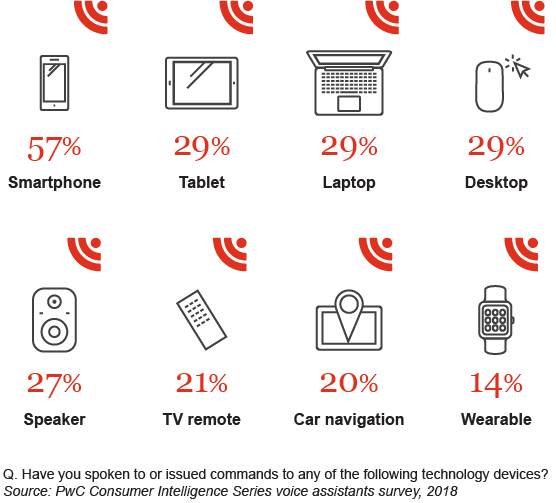


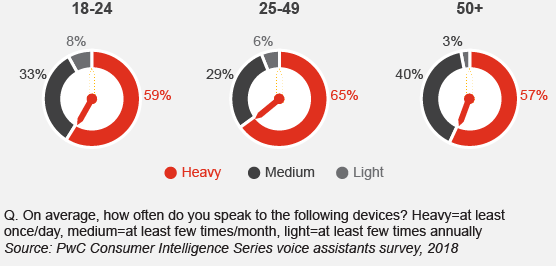

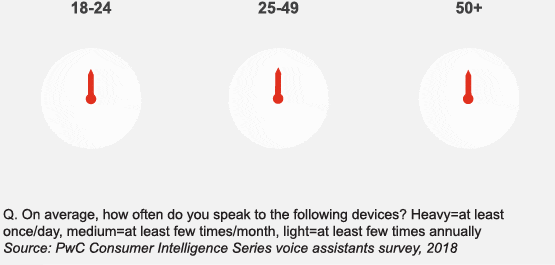
Younger consumers are driving adoption but not necessarily heavy usage
Though the youngest consumers we surveyed (18-24-year olds) are adopting voice technology at a faster rate than their older counterparts, they are statistically more likely to use their voice assistants less. 25-49-year olds are using them most often and are statistically more likely to be considered “heavy” users.
Really, how mobile are “mobile” voice assistants?
Despite being accessible everywhere, three out of every four consumers (74%) are using their mobile voice assistants at home. The majority of focus group participants were quick to say that they prefer privacy when speaking to their voice assistant and that using it in public “just looks weird.”
This could explain why 18-24-year olds are using their voice assistants less, as this age group tends to spend more time outside the home.
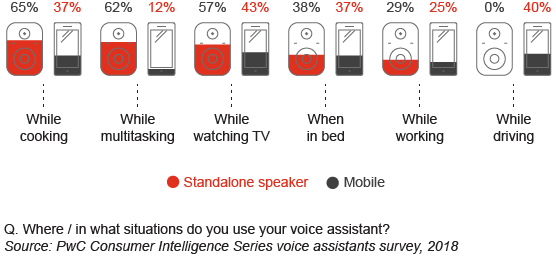
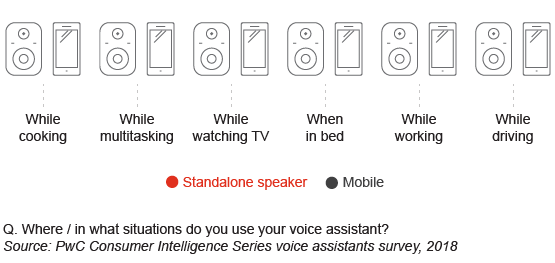
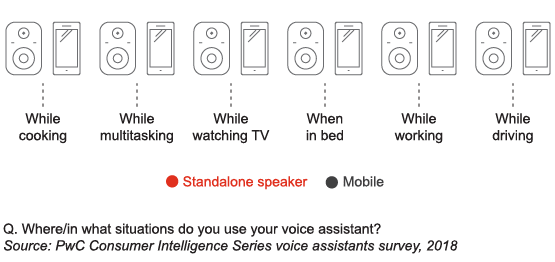
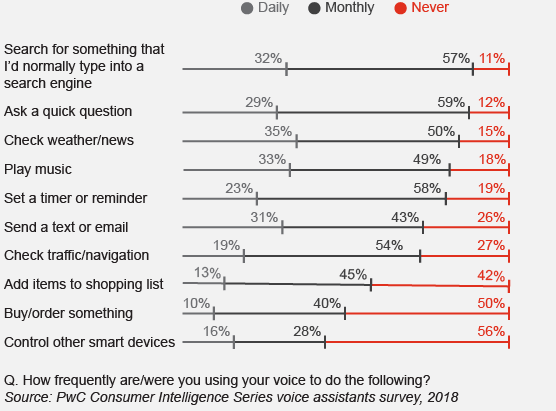
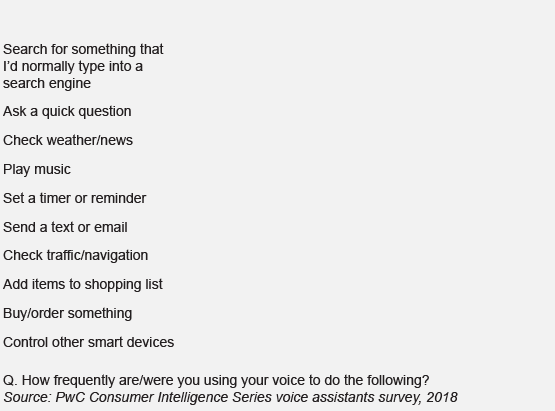
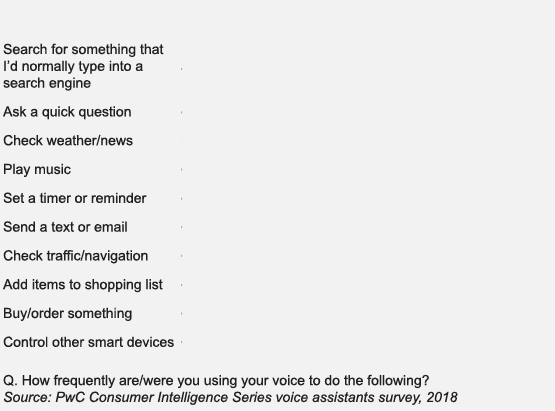
Despite growing capabilities, basic tasks remain the norm
For now, the bulk of consumers have yet to graduate to more advanced activities like shopping or controlling other smart devices in the home. Males and younger consumers are more likely to experiment with newer, more advanced features, but even then, it’s at a minimum.
Lack of experimentation stems primarily from three things:

Limited knowledge of the full breadth of capabilities
“The biggest hurdle for me has been awareness, like understanding what I’m able to do with these devices.”
Female, 37

A lack of trust
“The assistant can’t answer my questions half the time but I’m supposed to trust it to help me with something involving money?”
Female, 26

Hesitation due to complexity or price
“There is a lack of information currently about what works with what, and what doesn’t. And I fear spending hundreds of dollars on something that doesn’t work with what I already have.”
Male, 44
How do voice assistants stack up?
Consumers see voice assistants as the smarter, faster, and easier way to perform everyday activities. Yet, for more serious situations involving money (shopping, refund on an airline ticket, etc.), consumers prefer what they already know and trust—at least for now.
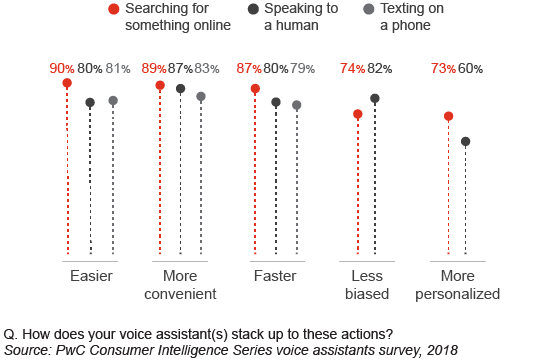
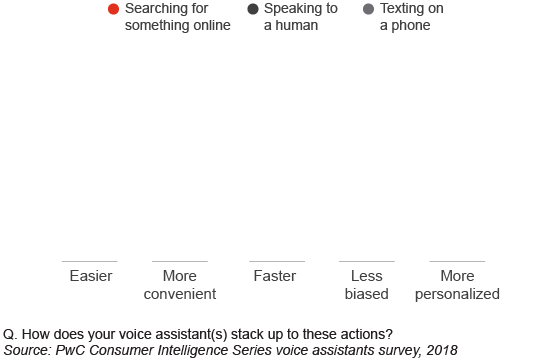
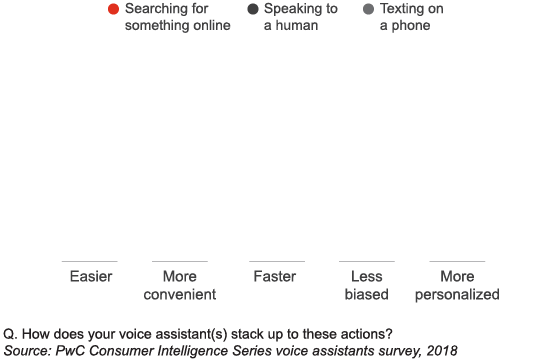
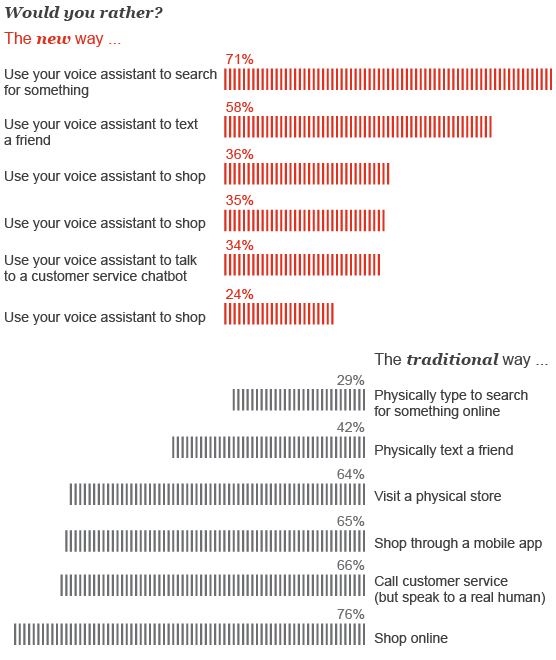


Trust remains a barrier for voice assistant shoppers
“I would shop for simple things like dog food, toilet paper, pizza… but ‘can you order me a sweater?’ That’s too risky.”
50% of respondents have made a purchase using their voice assistant, and an additional 25% would consider doing so in the future. The majority of items purchased are small and quick and are things that someone could buy without necessarily having to see it physically (to determine quality, for example).
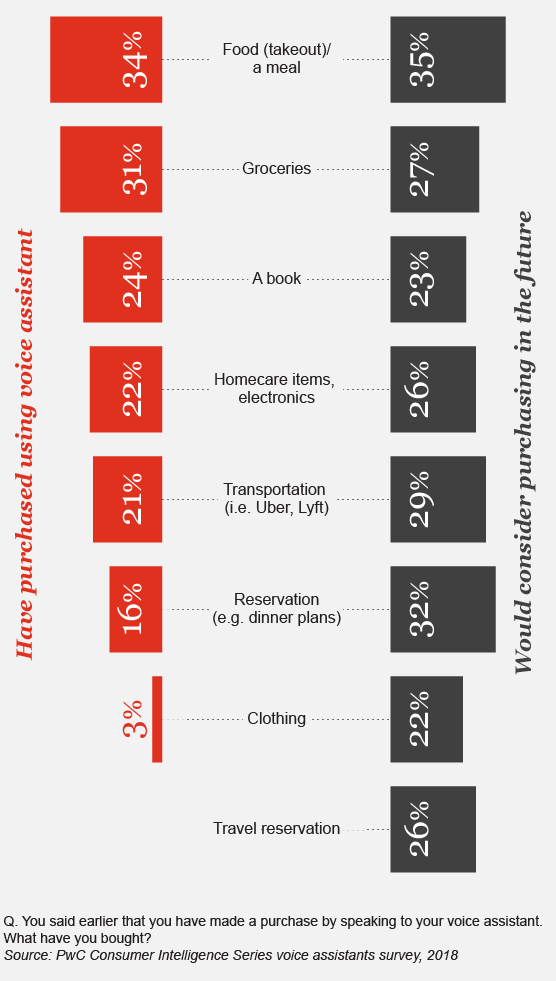
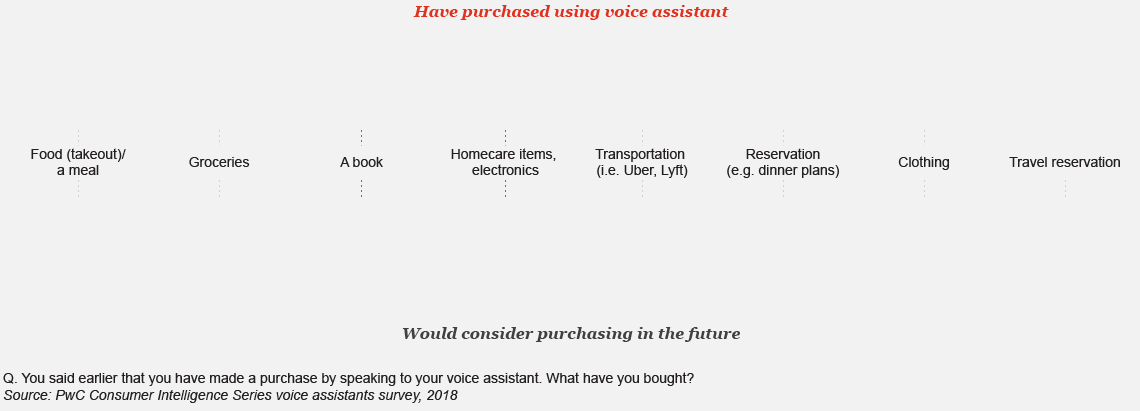
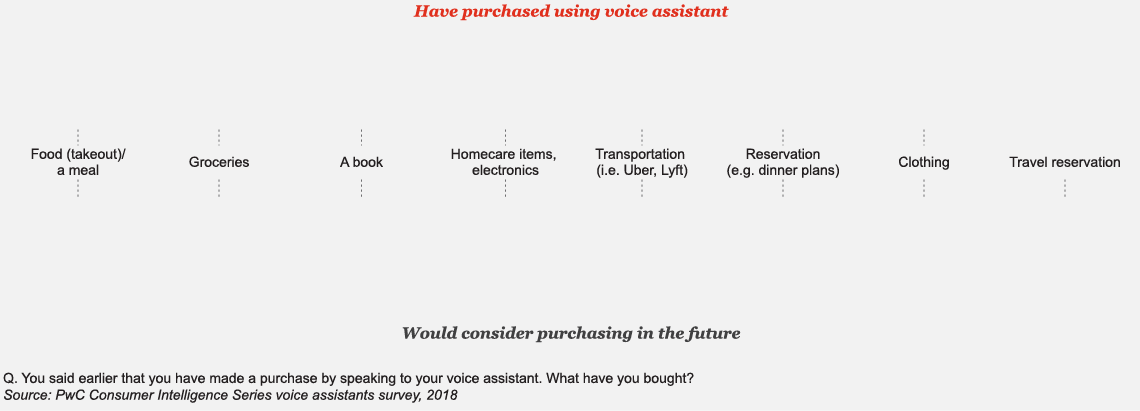
A positive shopping experience can mean deeper loyalty, greater trust, and more money spent. On average, 80% of consumers who have shopped using their voice assistant are satisfied, and as a result:
- 39% shared their positive experiences with friends and family
- 39% shopped again with the same retailer
- 36% have a more favorable opinion of the retailer
- 24% spent more money with the retailer
Yet, lack of trust is still palpable. One out of every four consumers would not consider shopping through their voice assistant now or in the future:
- 46% said “I don't trust my voice assistant to correctly interpret and process my order”
- 45% said “I don't trust or feel comfortable sending payment through my voice assistant”
Privacy is also a concern. For example, one focus group participant was adamant about the need for her voice assistant to be able to detect if she was alone prior to making recommendations based upon her past purchase history.
There was also unease around others in the household (kids, spouses, etc.) having access to the voice assistant and being able to purchase things with a pre-authorized credit card:
“This reminds me of when my daughter racked up almost $1,500 playing a mobile game... Can it get to a point where the device can confirm it’s me who’s talking and not my 11-year-old who’s going rogue? Or maybe you have to confirm the purchase by entering the last three digits of your credit card.”
Consumers want control over ads so they don't interfere
When forced to choose, 57% of consumers said they would rather watch an ad in the middle of a TV show than listen to an ad spoken by their voice assistant. To make advertising more enticing for the latter, consumers agree they would be open to listening to ads through their voice assistant if:
- They can say "skip" if they don't like an ad—88%
- They are asked if they want to hear the ad before it plays—82%
- Ads don’t interrupt pre-identified events (e.g., listening to music)—81%
- They get to choose the ad they listen to—80%
- Ads are only played at pre-approved times (e.g., not during dinner)—79%
- Ads are personalized by comments/questions previously spoken to their voice assistant—73%
- Ads are seamlessly embedded into answers (e.g. ask for restaurant, answer with paying advertiser)—71%
- They can interact with the ad by speaking to it—70%
- Ads are connected to "liked" brands on their social networks—70%
Where do you draw the line? For many consumers, über-personalization can cross the line.
"If I want to try out a new coffee brand and an ad for it shows up on [my social media account], fair enough. I was looking for it on the internet anyway. But if the voice assistant listens to everyday conversations I have with people in my life and then uses what’s said to recommend things, that’s just weird to me and I think it oversteps the boundaries of technology.”
Consumers were vocal about the need to trust the assistant to fulfill simple tasks in order for them to be open to more “invasive” types of personalization… and trust takes time.
Voice assistants influence smart home purchases, and vice versa
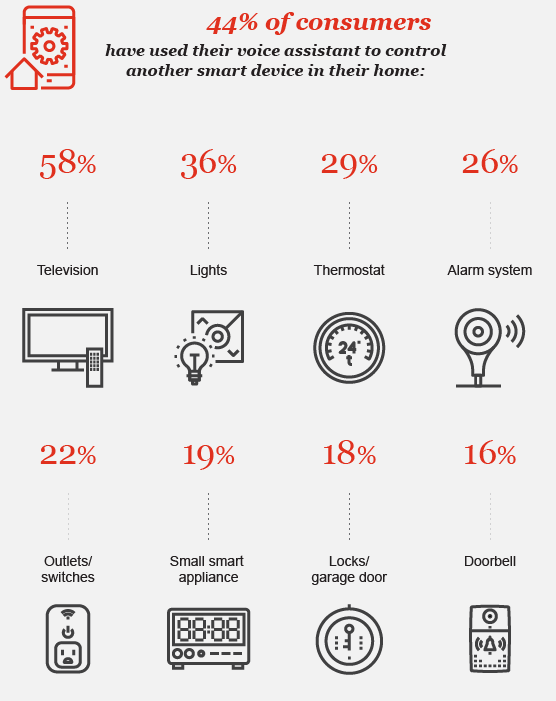


When shopping for a smart home device or product, 89% of consumers said they were influenced by its compatibility with their voice assistant. The reverse is also true—85% said a smart device(s) they owned influenced what kind of voice assistant they used/purchased.
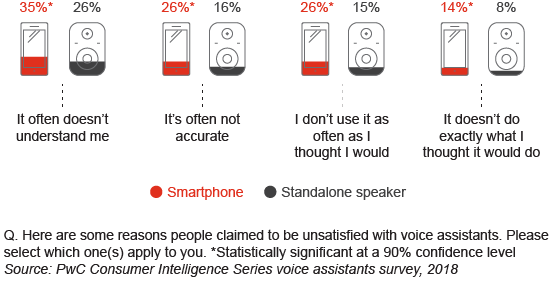
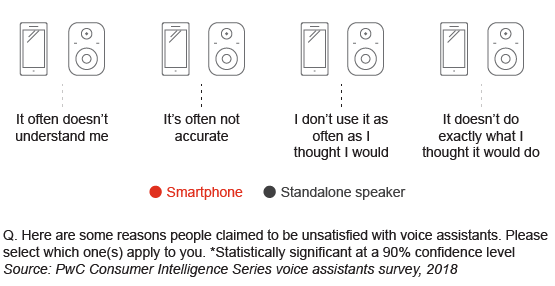
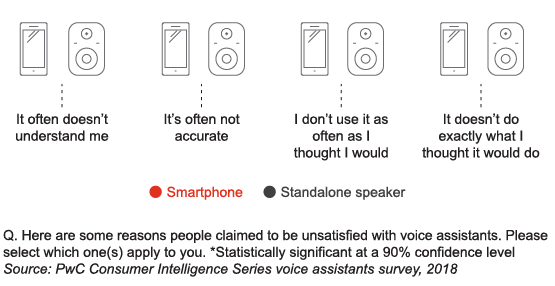
Overall satisfaction with voice assistants is high but smartphones lag
93% of consumers are satisfied with their voice assistants; 50%, very satisfied. Voice assistants help people feel organized (50% agree), informed (45%), happy (37%), smart (35%), confident (31%), and free (30%).
Yet, cracks begin to show when comparing satisfaction across devices. Voice assistants on smartphones have the lowest consumer satisfaction rate (38% very satisfied). These users expressed frustration with an apparent lack of understanding, reliability, and accuracy—and when compared directly to that of a standalone speaker, the differences are significant. Maturity is a factor here, as smartphones were among the earliest iterations of voice assistants years ago when the technology was still in its infancy.
Some consumers see voice assistants as a privacy risk
18% of the respondents who were familiar with voice technology have never used a voice assistant—and half of those, (9%) have no interest in using one in the future.
“If when I was dealing with more sensitive information [like credit card numbers or payments] it only responded to my voice, that would be one thing. But anybody could get on and access that information with or without the sound of my voice. It’s unsafe.”
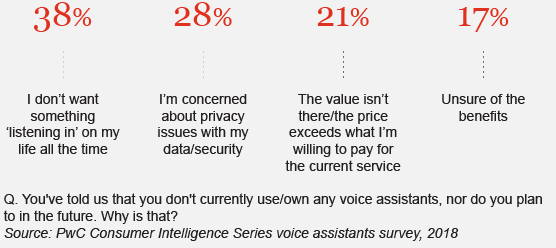
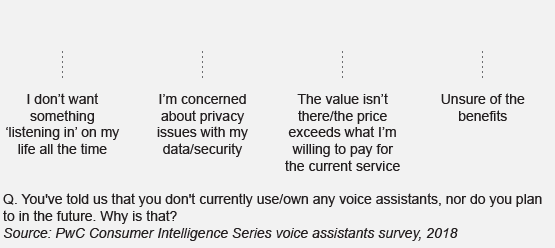
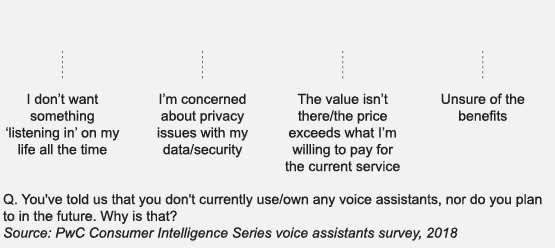
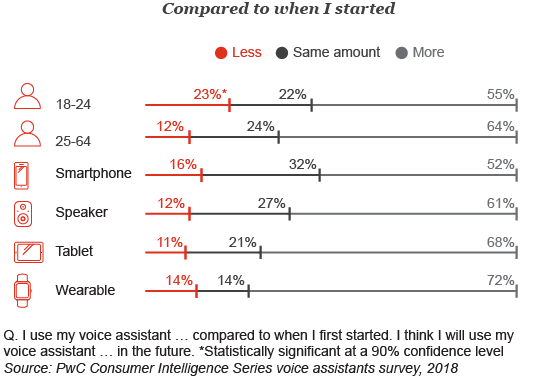
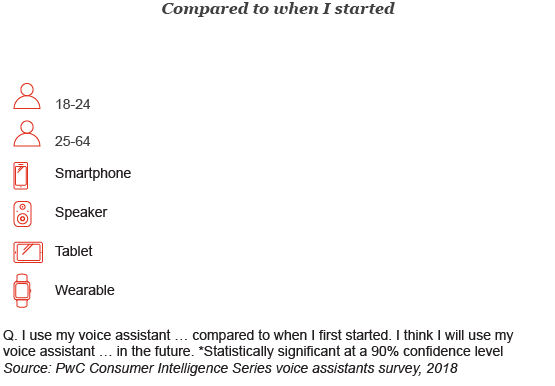
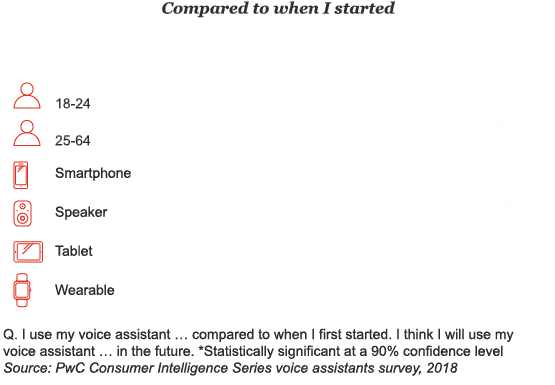
Usage will continue to increase but consistency must improve for wider adoption
The average consumer is using their voice assistant more than they were before, and will use it even more in the future. Differences can be seen, however, among the youngest consumers we surveyed (18-24-year olds) and usage with smartphone voice assistants, with both groups exhibiting significantly less usage as time goes on.
As voice assistants become more pervasive, they should aim to meet certain criteria with every task. At bare minimum, consumers expect their voice assistants to:
- Be correct / accurate / consistent—73% agree
- Understand the accent/diction every time someone speaks—61%
- Save time—59%
- Tell the difference between multiple voices—57%
- Help make life easier—55%
Set yourself up for success

Prepare and optimize for voice success
Customer relationships and perception of brands is expected to change as companies will have the opportunity to engage with their consumers on an individual level. Make voice a priority by driving and implementing a voice strategy. For example, create new voice-based business models to balance diminishing traditional screen-based revenue streams. Or anticipate customer needs using big data and predictive analysis and then provide relevant, up-to-date information by making the information on your website voice-ready.

Foster trust through consistency
Consumers are hesitant to try advanced capabilities with their voice assistants. A primary reason is an overall lack of trust in their devices to accurately understand and complete the most basic of asks. “If my voice assistant says ‘I don’t know the answer to that’ for every other question I ask, how can I expect it to help me plan and book my vacation, which is costing me a lot of money?” Work on perfecting the technology to allow for a seamless and reliable user experience.

Prioritize education and diminish complexity
Consumers are lazy. For example, most voice assistant owners haven’t created their own ‘recipes’ using services like “if this, then that” (IFTTT). They have limited knowledge that includes boundaries marked by information that’s readily accessible and easily understood. To guide consumers past “what’s the weather?” and towards “buy this pair of pants,” companies must first build trust through proof of concept with smaller tasks and then educate around what’s possible.
“Say I were to buy [a device] today. I would hope that the company would email me, like, congratulations, you just got [this device], with videos of everything I can do with it.” Male, 42

Ease into advertising
The advertising landscape on voice assistants is ripe with opportunity, but it needs to be cautiously approached by businesses. There’s a risk of losing customers due to invasive or annoying ads, so it’s essential for companies to seamlessly integrate their advertising in a way that doesn’t disrupt the consumer experience. Look at advertising as an addition to or an extension of the content as opposed to something akin to a popup ad.

Understand boundaries to mitigate privacy concerns
“Increased personalization” was deemed the least impactful benefit of voice assistants, at 46% agreement. We know that consumers value personalization and services that make life easier, but there is a fine line between being “cool” or “helpful” and being “creepy.” The key is to use personal consumer data in a secure and transparent way to create personalized experiences that the consumer wants and has asked for. Consumers are not yet comfortable with the voice assistant being autonomous.

Be patient
Voice assistants are seen positively by consumers, and when compared to everyday devices and activities, they are viewed as being smarter, easier, and faster. They are not always preferred, however. As with any new technology, it takes consumers time to adjust. Once there is a solid foundation of trust and reliability, voice assistants are primed to wholly transform lives everywhere.



It begins with awareness, continues with experience, and ends with trust. To lay the groundwork, consumers must first understand the capabilities and value proposition of voice devices and assistants. Next, voice capabilities should continue to evolve to the point where they are accurate and successfully meet their consumer’s needs in a unique and satisfying way. This seamless user experience will help to foster trust, reliability, transparency, validation, and control. Protect consumer privacy, don’t sell their data, and refrain from being “creepy.”
How “voice assistants” was defined for the respondents
Examples of voice assistants include ones on your mobile device, like Apple’s Siri and Samsung’s Bixby, and standalone smart speakers like Amazon Alexa Echo, Microsoft Cortana, etc.
Things you can do with your voice assistant include:
- Using your voice to ask your digital assistant—like Google Home—for today’s weather, a funny joke, or to set a reminder
- Asking your voice assistant, Amazon Alexa, to turn down the temperature via your Nest smart thermostat
- Asking Apple’s Siri to tell you today’s headline news








